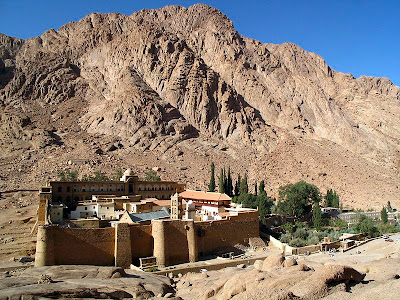Saint Catherine's Monastery (Greek: Μονὴ τῆς Ἁγίας Αἰκατερίνης Moni tes Hagias Aikaterines) lies on the Sinai Peninsula, at the mouth of a gorge at the foot of Mount Sinai in the city of Saint Catherine in Egypt's South Sinai Governorate. The monastery is Orthodox and is a UNESCO World Heritage Site. According to the UNESCO report (60100 ha / Ref: 954), this monastery is one of the oldest working Christian monasteries in the world together with the Monastery of Saint Anthony, situated across the Red Sea in the desert south of Cairo, which also lays claim to that title.
History
The oldest record of monastic life at Sinai comes from the travel journal written in Latin by a woman named Egeria about 381-384. She visited many places around the Holy Land and Mount Sinai, where, according to the Hebrew Bible, Moses received the Ten Commandments from God.
The monastery was built by order of Emperor Justinian I (reigned 527-565), enclosing the Chapel of the Burning Bush ordered to be built by Helena, the mother of Constantine I, at the site where Moses is supposed to have seen the burning bush; the living bush on the grounds is purportedly the original. It is also referred to as "St. Helen's Chapel." The site is sacred to Judaism, Christianity and Islam.
Though it is commonly known as Saint Catherine's, the full, official name of the monastery is, The Sacred and Imperial Monastery of the God-Trodden Mount of Sinai, and the patronal feast of the monastery is the Transfiguration. The site was associated with Saint Catherine of Alexandria (whose relics were purported to have been miraculously transported there by angels) and it became a favorite site of pilgrimage.
According to tradition, Catherine of Alexandria was a Christian martyr initially sentenced to death on the wheel. However, when this failed to kill her, she was beheaded. According to tradition, angels took her remains to Mount Sinai. Around the year 800, monks from the Sinai Monastery found her remains.
The monastery possesses copies of an important historical document, the Achtiname, in which Muhammad is claimed to have bestowed his protection upon the monastery.
A Fatimid mosque was built within the walls of the monastery, but it has never been used since it is not correctly oriented towards Mecca.
During the seventh century, the isolated Christian anchorites of the Sinai were eliminated: only the fortified monastery remained. The monastery is still surrounded by the massive fortifications that have preserved it. Until the twentieth century, access was through a door high in the outer walls. From the time of the First Crusade, the presence of Crusaders in the Sinai until 1270 spurred the interest of European Christians and increased the number of intrepid pilgrims who visited the monastery. The monastery was supported by its dependencies in Egypt, Palestine, Syria, Crete, Cyprus and Constantinople.
The monastery is depicted as a scene on the back panel of the Modena Triptych by El Greco.
It is seen in the PBS documentary, Walking the Bible with Bruce Feiler.
About the monastery
The monastery library preserves the second largest collection of early codices and manuscripts in the world, outnumbered only by the Vatican Library. Its strength lies in Greek, Arabic, Armenian, Hebrew, Georgian, Syriac and old Udi texts. The Codex Sinaiticus, now in the British Library, left the monastery in the 19th century for Russia, in circumstances that are now disputed.
The complex houses irreplaceable works of art: mosaics, the best collection of early icons in the world, many in encaustic, as well as liturgical objects, chalices and reliquaries, and church buildings. The large icon collection begins with a few dating to the 5th (possibly) and 6th centuries, which are unique survivals, the monastery having been untouched by Byzantine iconoclasm, and never sacked. The oldest icon on an Old Testament theme is also preserved there. A project to catalogue the collections has been ongoing since the 1960s.
The monastery, along with several dependencies in the area, constitute the entire Orthodox Church of Mount Sinai, which is headed by an archbishop, who is also the abbot of the monastery. The exact administrative status of the church within Eastern Orthodoxy is ambiguous: by some, including the church itself, it is considered autocephalous, by others an autonomous church under the jurisdiction of the Greek Orthodox Church of Jerusalem. The archbishop is traditionally consecrated by the Orthodox Patriarch of Jerusalem; in recent centuries he has usually resided in Cairo. During the period of the Crusades, marked by bitterness between the Orthodox and Catholic churches, the monastery was patronized by both the Byzantine Emperors and the rulers of the Kingdom of Jerusalem, and their respective elites. The monastery was an important centre for the development of the hybrid style of Crusader art, and still retains over 120 icons created in the style, by far the largest collection in existence. Many were evidently created by Latins, probably monks, based in or around the monastery in the 13th century. Prior to September 1, 2009, a previously unseen fragment of Codex Sinaiticus was discovered in the monastery's library.









